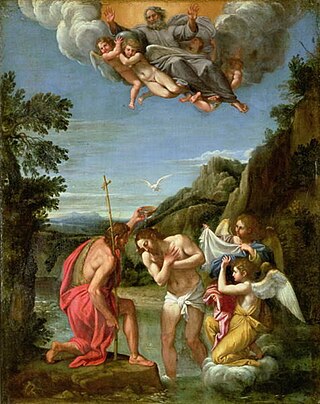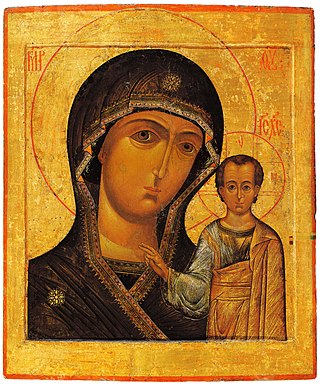
Adoptionism, also called dynamic monarchianism, is an early Christian nontrinitarian theological doctrine, subsequently revived in various forms, which holds that Jesus was adopted as the Son of God at his baptism, his resurrection, or his ascension. How common adoptionist views were among early Christians is debated, but it appears to have been most popular in the first, second, and third centuries. Some scholars see adoptionism as the belief of the earliest followers of Jesus, based on the epistles of Paul and other early literature. However, adoptionist views sharply declined in prominence in the fourth and fifth centuries, as Church leaders condemned it as a heresy.
The Chalcedonian Definition is a declaration of Christ's nature, adopted at the Council of Chalcedon in AD 451. Chalcedon was an early centre of Christianity located in Asia Minor. The council was the fourth of the ecumenical councils that are accepted by Chalcedonian churches which include the Catholic, Eastern Orthodox, Lutheran, Anglican and Reformed churches.

In Christianity, Christology, translated from Greek as 'the study of Christ', is a branch of theology that concerns Jesus. Different denominations have different opinions on questions such as whether Jesus was human, divine, or both, and as a messiah what his role would be in the freeing of the Jewish people from foreign rulers or in the prophesied Kingdom of God, and in the salvation from what would otherwise be the consequences of sin.

Theotokos is a title of Mary, mother of Jesus, used especially in Eastern Christianity. The usual Latin translations are Dei Genitrix or Deipara. Familiar English translations are "Mother of God" or "God-bearer" – but these both have different literal equivalents in Greek, Μήτηρ Θεοῦ and Θεοφόρος.
Chalcedonian Christianity is a term referring to the branches of Christianity that accept and uphold theological resolutions of the Council of Chalcedon, the fourth ecumenical council, held in 451. Chalcedonian Christianity accepts the Christological Definition of Chalcedon, a Christian doctrine concerning the union of two natures in one hypostasis of Jesus Christ, who is thus acknowledged as a single person (prosopon). Chalcedonian Christianity also accepts the Chalcedonian confirmation of the Niceno-Constantinopolitan Creed, thus acknowledging the commitment of Chalcedonism to Nicene Christianity.
Incarnation literally means embodied in flesh or taking on flesh. It is the conception and the embodiment of a deity or spirit in some earthly form or an anthropomorphic form of a god. It is used to mean a god, deity, or Divine Being in human or animal form on Earth. The proper noun, Incarnation, refers to the union of divinity with humanity in Jesus Christ.
In Christian theology, divinization, or theopoesis or theosis, is the transforming effect of divine grace, the spirit of God, or the atonement of Christ. Although it literally means to become divine, or to become God, most modern Christian denominations do not interpret the doctrine as implying an overcoming of a fundamental ontological difference between God and humanity; for example, John of the Cross indicated that while "God communicates to it [the individual soul] His supernatural Being, in such wise that it appears to be God Himself, and has all that God Himself has", yet "it is true that its natural being, though thus transformed, is as distinct from the Being of God as it was before".

The real presence of Christ in the Eucharist is the Christian doctrine that Jesus Christ is present in the Eucharist, not merely symbolically or metaphorically, but in a true, real and substantial way.
In Christian theology, kenosis is the "self-emptying" of Jesus. The word ἐκένωσεν is used in the Epistle to the Philippians: "[Jesus] made himself nothing" (NIV), or "[he] emptied himself" (NRSV), using the verb form κενόω, meaning "to empty".
Communicatio idiomatum is a Christological concept about the interaction of deity and humanity in the person of Jesus Christ. It maintains that in view of the unity of Christ's person, his human and divine attributes and experiences might properly be referred to his other nature so that the theologian may speak of "the suffering of God".
Hypostatic union is a technical term in Christian theology employed in mainstream Christology to describe the union of Christ's humanity and divinity in one hypostasis, or individual personhood.
Miaphysitism is the Christological doctrine that holds Jesus, the "Incarnate Word, is fully divine and fully human, in one 'nature' (physis)." It is a position held by the Oriental Orthodox Churches and differs from the Chalcedonian position that Jesus is one "person" in two "natures", a divine nature and a human nature (dyophysitism).

Girolamo Zanchi was an Italian Protestant Reformation clergyman and educator who influenced the development of Reformed theology during the years following John Calvin's death.
The Ubiquitarians, also called Ubiquists, were a Protestant sect that held that the body of Christ was everywhere, including the Eucharist. The sect was started at the Lutheran synod of Stuttgart, 19 December 1559, by Johannes Brenz (1499–1570), a Swabian. Its profession, made under the name of Duke Christopher of Württemberg and entitled the "Württemberg Confession," was sent to the Council of Trent in 1552, but had not been formally accepted as the Ubiquitarian creed until the synod at Stuttgart.

Sacramental union is the Lutheran theological doctrine of the Real Presence of the body and blood of Christ in the Christian Eucharist.
Scholastic Lutheran Christology is the orthodox Lutheran theology of Jesus, developed using the methodology of Lutheran scholasticism.

Dyophysitism is the Christological position that Jesus Christ is one person of one substance and one hypostasis, with two distinct, inseparable natures, divine and human. It is related to the doctrine of the hypostatic union. Those who insisted on the "two natures" formula were referred to as dyophysites.
Divine presence, presence of God, Inner God, or simply presence is a concept in religion, spirituality, and theology that deals with the ability of a deity to be "present" with human beings, sometimes associated with omnipresence.
Dyothelitism or dithelitism is the Christological doctrine that teaches the existence of two wills in the person of Jesus Christ. Specifically, dyothelitism correlates the distinctiveness of two wills with the existence of two specific natures in the person of Jesus Christ, in a dyophysite context.
Christian theology is the theology – the systematic study of the divine and religion – of Christianity and Christian belief and practice. It concentrates primarily upon the texts of the Old Testament and of the New Testament, as well as on Christian tradition. Christian theologians use biblical exegesis, rational analysis and argument. Theologians may undertake the study of Christian theology for a variety of reasons, such as in order to:






